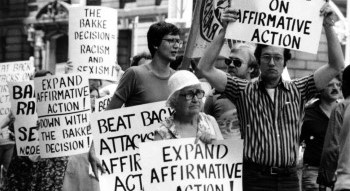
"Affirmative action is a little like the professional football draft. The NFL awards its No. 1 draft choices to the lowest-ranked team in the league. It doesn't do this out of compassion or guilt. It's done for mutual survival. They understand that a league can only be as strong as its weakest team." - J.C. Watts
Common Misconceptions about Affirmative Action
- Color-blind policies often put racial minorities at a disadvantage. Systems that protect senior employees or legacy students overwhelmingly favor white workers and students as those groups have earlier advantages that benefited from minority disenfranchisement.
- Despite much progress, the playing field is far from level. On average, women still earn less money than men; black communities experience much higher unemployment rates; and black families have half the median income of white families.
- Affirmative Action is not reverse discrimination. Affirmative Action policies seek to remove barriers that would prevent the hiring or admission of women and minorities, not exclude white participation.
- Affirmative Action has been supported by both Republican and Democratic presidential administrations since its introduction.
How to have a conversation about Affirmative Action
- Lead with Values: Instead of focusing on dry facts or controversial accusations, begin the conversation with the shared values of most Americans.
- Resist the "self-made person" frame: Avoid using framing devices around hard work and individual merit in these conversations. Stick to addressing systematic barriers, inequities, and their solutions.
- Over-Document examples of inequality: Most audiences are uninformed on continuing issues of racial bias in specific systems such as the banking and lending industry, school quality, and institutional hiring practices. Provide excessive evidence about these racial disparities to overcome any initial skepticism.
- Acknowledge the elephant in the room: Most Americans want open opportunities for others, but are also worried about their own security. Center the conversation on the shared vision to create opportunities for everyone.